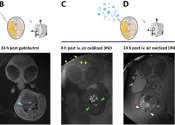Diamond dust as a potential alternative to contrast agent gadolinium in magnetic resonance imaging
An unexpected discovery surprised a scientist at the Max Planck Institute for Intelligent Systems in Stuttgart: Nanometer-sized diamond particles, which were intended for a completely different purpose, shone brightly in ...









